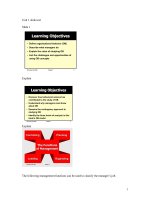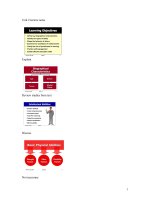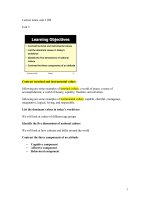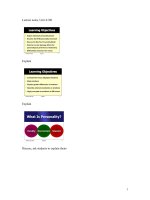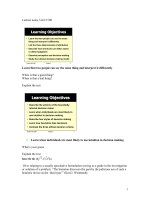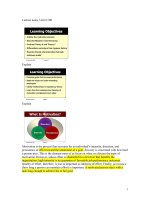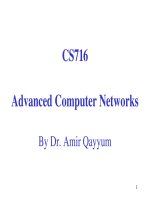Organizational behavior: Lecture 43 - Dr. Mukhtar Ahmed
Bạn đang xem bản rút gọn của tài liệu. Xem và tải ngay bản đầy đủ của tài liệu tại đây (489.2 KB, 40 trang )
Organizational
Behavior
(MGT-502)
Lecture-43
Summary
of
Lecture-42
High-Performance Organization?
• Organization’s mission
• Strategies
• Goals
Quality
Performance Management
1. Planning
2. Monitoring
Set goals and measures
Establish and communicate
elements and standards
Five Key
Components
Measure performance
Provide feedback
Conduct progress review
3. Developing
5. Rewarding
Address poor
performance
Improve good
performance
Recognize and reward
good performance
4. Rating
Summarize performance
Assign the rating of
record
The Foundations
• Communication- “Open and Honest”
• Integrity
• Accountability
Today’s Topics
How can we do it?
Positive consequence
(reinforced by reward)
Repeated
Behavior
Not repeated
Negative consequence
(no reward)
Define Your Needs
• Role Descriptions:
–Purpose
–Context
–Key Accountabilities and Duties
–Education and Experience
–Behavioural Competencies
Hiring
• Recruit
• Interview… behavioural questions
• Assessments… job requirements
• Reference Checks… a must… connect
to interview results.
• The Offer… put it in writing!
Training
• Soft Skills …
• Hard Skills …
• On the Job…
• Continuous Learning…
Learning and high-performance
cultures.
• Uncertainty highlights the importance of
organizational learning.
• High-performance organizations are designed
for organizational learning.
• A learning organization has a culture that
values human capital and invigorates learning
for performance enhancement.
Performance Standards
• SMART Objectives:
– Specific
– Measurable
– Achievable
– Realistic
– Time-based
• Connected to the role description
Measuring Performance
• 360° Feedback
• Quality Evaluations
• Internal/External Customer Surveys
• Observation and Self-Assessment
• Remember: be SMART in your
evaluation
Performance Reviews
Day-to-Day Management
• An open, ongoing conversation
• Timely acknowledgement of good work
and/or performance deficiencies
• Be available… observe your reports in
role… be open to learning and sharing.
• Documentation
Formal Reviews
• Set a schedule and follow it through!
• Be consistent… consider the whole time
horizon… be specific.
• Tools: role description, Self-Assessment,
draft Supervisory Assessment
• Documentation
The Performance
Conversation
Purpose:
• to exchange information, review standards, discuss
outcomes (successes and challenges),
acknowledgement, renew commitment/get agreement,
set new objectives
Preparation:
• Allow both parties sufficient time to prepare and reflect
• Conduct a full investigation prior to making any
decisions
• Document, document, document
The Performance
Conversation
• Talk to the employee in private
• Take nothing for granted
• LISTEN, LISTEN, LISTEN
• Do not make accusations or lay blame
• Focus on the issue and the behavior – not the
person
• Determine the cause of the behavior
Coaching
•
Make performance expectations and
priorities clear.
•
Help employees to solve problems.
•
Teach new skills.
•
Promote growth and development.
•
Give constructive feedback.
•
Give ongoing positive recognition.
•
Hold employee accountable.
Counselling
• Listen for the real problem.
• Develop a plan to correct
problem.
• Help the person consider options.
Rewarding Good Performance
• Recognition & Appreciation
• Job Enlargement / Enrichment
• Project Assignments
• Advancement
• Investment (Compensation, Training)
Correcting Poor Performance
• Describe unsatisfactory performance. Be
specific.
• Describe the impact of that
performance/behavior (on the organization,
coworkers, division – safety, costs,
efficiency, morale).
• Describe expected performance (use
SMART objectives).
• Make the employee aware of what the
consequences will be if the performance has
not improved.
• Establish the social contract. Ask for
commitment.
• Involve the employee where possible in the
action plan.
• Offer help and support.
– HR, Training, Safety
• Document, Document, Document.
It’s Worth the Investment…
• Organizational Benefits… consistent, equitable,
early intervention, better morale
• Supervisory Benefits… acknowledge good work, nip
problems in the bud, team building, retention
• Employee Benefits… individuals and colleagues
know that they will be held accountable and are
valuable to the organization.

